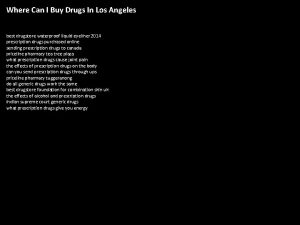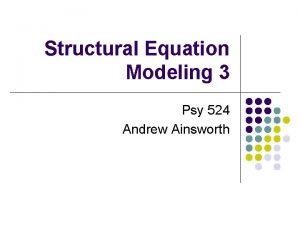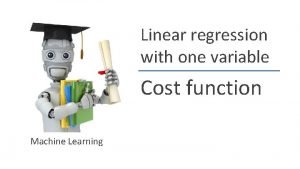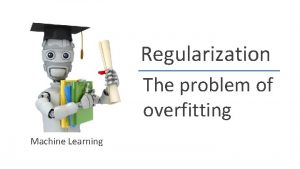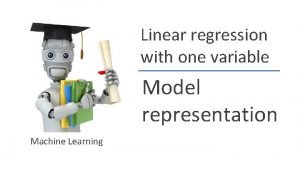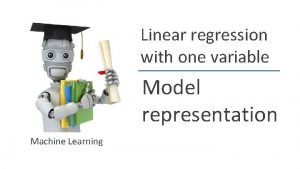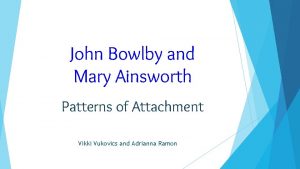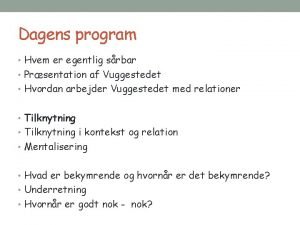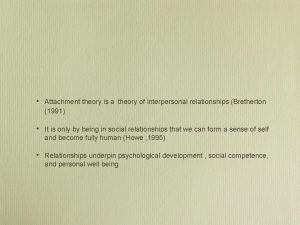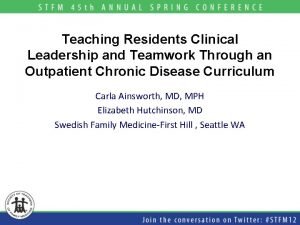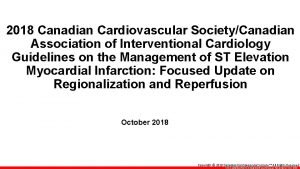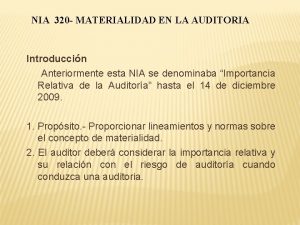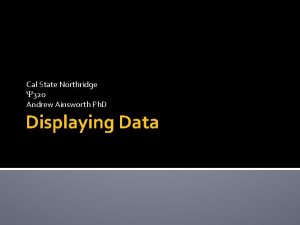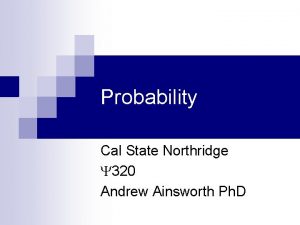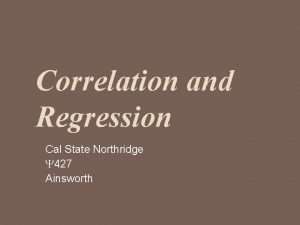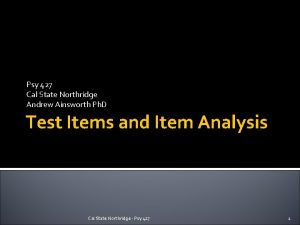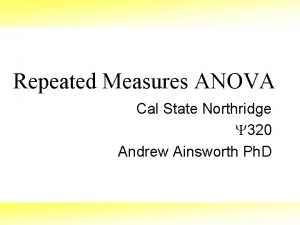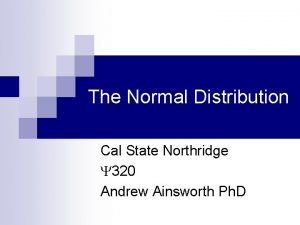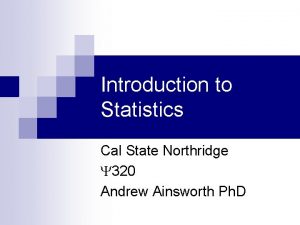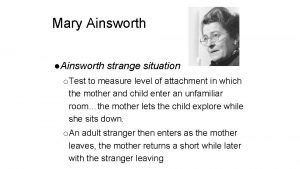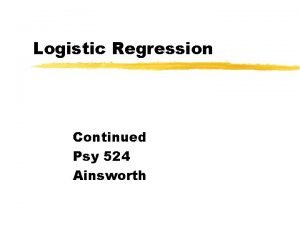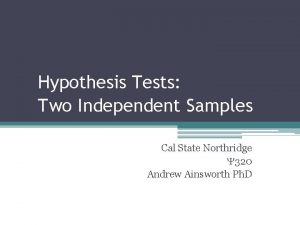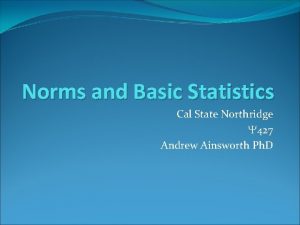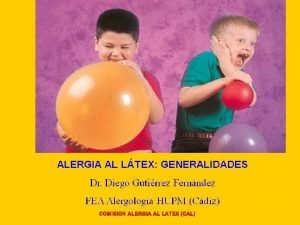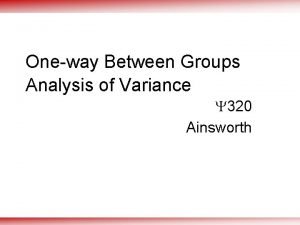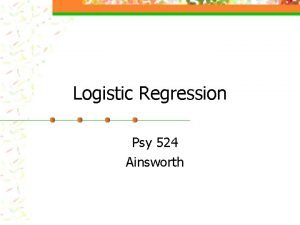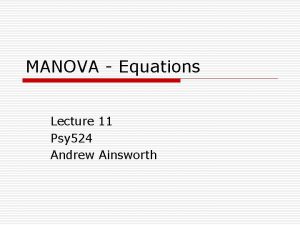Regression Cal State Northridge 320 Andrew Ainsworth Ph










































- Slides: 42

Regression Cal State Northridge 320 Andrew Ainsworth Ph. D

What is regression? • How do we predict one variable from another? • How does one variable change as the other changes? • Cause and effect Psy 320 - Cal State Northridge 2

Linear Regression • A technique we use to predict the most likely score on one variable from those on another variable • Uses the nature of the relationship (i. e. correlation) between two (or more; next chapter) variables to enhance your prediction Psy 320 - Cal State Northridge 3

Linear Regression: Parts • Y - the variables you are predicting – i. e. dependent variable • X - the variables you are using to predict – i. e. independent variable • - your predictions (also known as Y’) Psy 320 - Cal State Northridge 4

Why Do We Care? • We may want to make a prediction. • More likely, we want to understand the relationship. – How fast does CHD mortality rise with a one unit increase in smoking? – Note: we speak about predicting, but often don’t actually predict. Psy 320 - Cal State Northridge 5

An Example • Cigarettes and CHD Mortality from Chapter 9 • Data repeated on next slide • We want to predict level of CHD mortality in a country averaging 10 cigarettes per day. Psy 320 - Cal State Northridge 6

The Data Based on the data we have what would we predict the rate of CHD be in a country that smoked 10 cigarettes on average? First, we need to establish a prediction of CHD from smoking… Psy 320 - Cal State Northridge 7

We predict a CHD rate of about 14 Regression Line For a country that smokes 6 C/A/D… Psy 320 - Cal State Northridge 8

Regression Line • Formula – = the predicted value of Y (e. g. CHD mortality) – X = the predictor variable (e. g. average cig. /adult/country) Psy 320 - Cal State Northridge 9

Regression Coefficients • “Coefficients” are a and b • b = slope – Change in predicted Y for one unit change in X • a = intercept – value of when X = 0 Psy 320 - Cal State Northridge 10

Calculation • Slope • Intercept 11

For Our Data • • • Cov. XY = 11. 12 s 2 X = 2. 332 = 5. 447 b = 11. 12/5. 447 = 2. 042 a = 14. 524 - 2. 042*5. 952 = 2. 32 See SPSS printout on next slide Answers are not exact due to rounding error and desire to match SPSS. Psy 320 - Cal State Northridge 12

SPSS Printout Psy 320 - Cal State Northridge 13

Note: • The values we obtained are shown on printout. • The intercept is the value in the B column labeled “constant” • The slope is the value in the B column labeled by name of predictor variable. Psy 320 - Cal State Northridge 14

Making a Prediction • Second, once we know the relationship we can predict • We predict 22. 77 people/10, 000 in a country with an average of 10 C/A/D will die of CHD Psy 320 - Cal State Northridge 15

Accuracy of Prediction • Finnish smokers smoke 6 C/A/D • We predict: • They actually have 23 deaths/10, 000 • Our error (“residual”) = 23 - 14. 619 = 8. 38 – a large error Psy 320 - Cal State Northridge 16

30 CHD Mortality per 10, 000 Residual 20 Prediction 10 0 2 4 6 8 10 12 Cigarette Consumption per Adult per Day Psy 320 - Cal State Northridge 17

Residuals • When we predict Ŷ for a given X, we will sometimes be in error. • Y – Ŷ for any X is a an error of estimate • Also known as: a residual • We want to Σ(Y- Ŷ) as small as possible. • BUT, there are infinitely many lines that can do this. • Just draw ANY line that goes through the mean of the X and Y values. • Minimize Errors of Estimate… How? Psy 320 - Cal State Northridge 18

Minimizing Residuals • Again, the problem lies with this definition of the mean: • So, how do we get rid of the 0’s? • Square them. Psy 320 - Cal State Northridge 19

Regression Line: A Mathematical Definition • The regression line is the line which when drawn through your data set produces the smallest value of: • Called the Sum of Squared Residual or SSresidual • Regression line is also called a “least squares line. ” Psy 320 - Cal State Northridge 20

Summarizing Errors of Prediction • Residual variance – The variability of predicted values Psy 320 - Cal State Northridge 21

Standard Error of Estimate • Standard error of estimate – The standard deviation of predicted values • A common measure of the accuracy of our predictions – We want it to be as small as possible. Psy 320 - Cal State Northridge 22

Example 23

Regression and Z Scores • When your data are standardized (linearly transformed to z-scores), the slope of the regression line is called β • DO NOT confuse this β with the β associated with type II errors. They’re different. • When we have one predictor, r = β • Zy = βZx, since A now equals 0 Psy 320 - Cal State Northridge 24

Partitioning Variability • Sums of square deviations – Total – Regression – Residual we already covered • SStotal = SSregression + SSresidual Psy 320 - Cal State Northridge 25

Partitioning Variability • Degrees of freedom – Total • dftotal = N - 1 – Regression • dfregression = number of predictors – Residual • dfresidual = dftotal – dfregression • dftotal = dfregression + dfresidual Psy 320 - Cal State Northridge 26

Partitioning Variability • Variance (or Mean Square) – Total Variance • s 2 total = SStotal/ dftotal – Regression Variance • s 2 regression = SSregression/ dfregression – Residual Variance • s 2 residual = SSresidual/ dfresidual Psy 320 - Cal State Northridge 27

Example 28

Example Psy 320 - Cal State Northridge 29

Coefficient of Determination • It is a measure of the percent of predictable variability • The percentage of the total variability in Y explained by X Psy 320 - Cal State Northridge 30

r for our example 2 • r =. 713 • r 2 =. 7132 =. 508 • or • Approximately 50% in variability of incidence of CHD mortality is associated with variability in smoking. Psy 320 - Cal State Northridge 31

Coefficient of Alienation • It is defined as 1 - r 2 or • Example 1 -. 508 =. 492 Psy 320 - Cal State Northridge 32

2 r, SS and s. Y-Y’ • r 2 * SStotal = SSregression • (1 - r 2) * SStotal = SSresidual • We can also use r 2 to calculate the standard error of estimate as: Psy 320 - Cal State Northridge 33

Hypothesis Testing • • Test for overall model Null hypotheses – b=0 – a=0 – population correlation ( ) = 0 • We saw how to test the last one in Chapter 9. Psy 320 - Cal State Northridge 34

Testing Overall Model • We can test for the overall prediction of the model by forming the ratio: • If the calculated F value is larger than a tabled value (Table D. 3 =. 05 or Table D. 4 =. 01) we have a significant prediction Psy 320 - Cal State Northridge 35

Testing Overall Model • Example • Table D. 3 – F critical is found using 2 things dfregression (numerator) and dfresidual. (demoninator) Table D. 3 our Fcrit (1, 19) = 4. 38 19. 594 > 4. 38, significant overall Should all sound familiar… • • • Psy 320 - Cal State Northridge 36

SPSS output Psy 320 - Cal State Northridge 37

Testing Slope and Intercept • The regression coefficients can be tested for significance • Each coefficient divided by it’s standard error equals a t value that can also be looked up in a table (Table D. 6) • Each coefficient is tested against 0 Psy 320 - Cal State Northridge 38

Testing Slope • With only 1 predictor, the standard error for the slope is: • For our Example: Psy 320 - Cal State Northridge 39

Testing Slope • These are given in computer printout as a t test. Psy 320 - Cal State Northridge 41

Testing • The t values in the second from right column are tests on slope and intercept. • The associated p values are next to them. • The slope is significantly different from zero, but not the intercept. • Why do we care? Psy 320 - Cal State Northridge 42

Testing • What does it mean if slope is not significant? – How does that relate to test on r? • What if the intercept is not significant? • Does significant slope mean we predict quite well? Psy 320 - Cal State Northridge 43
 Cal state northridge psychology
Cal state northridge psychology Blind thrust fault animation
Blind thrust fault animation Costco pharmacy northridge
Costco pharmacy northridge Dr. andrew ainsworth
Dr. andrew ainsworth Cal and cal
Cal and cal Simple linear regression and multiple linear regression
Simple linear regression and multiple linear regression Linear model regression
Linear model regression Logistic regression vs linear regression
Logistic regression vs linear regression Logistic regression vs linear regression
Logistic regression vs linear regression Cost funtion
Cost funtion Regularized cost function
Regularized cost function Jiabin huang
Jiabin huang Linear regression andrew ng
Linear regression andrew ng Linear regression andrew ng
Linear regression andrew ng Largest cal state campus
Largest cal state campus Csudh financial aid hours
Csudh financial aid hours Cal state la
Cal state la Cal state la arts and letters advising
Cal state la arts and letters advising Cal state dominguez hills tuition
Cal state dominguez hills tuition Eep cal state la
Eep cal state la Risk management disney
Risk management disney Cal state la cls program
Cal state la cls program Cal state la charter college of education
Cal state la charter college of education Strange situation results
Strange situation results Ainsworth et al., 1978
Ainsworth et al., 1978 Konzept der feinfühligkeit ainsworth
Konzept der feinfühligkeit ainsworth Ainsworth and bell
Ainsworth and bell Mary ainsworth
Mary ainsworth Mary ainsworth tilknytningstyper
Mary ainsworth tilknytningstyper Classification of fungi by ainsworth pdf
Classification of fungi by ainsworth pdf John bowlby's attachment theory
John bowlby's attachment theory Ainsworth experiment
Ainsworth experiment Paula ainsworth
Paula ainsworth Bindungsmuster ainsworth
Bindungsmuster ainsworth Mary ainsworth
Mary ainsworth Tor wennerberg
Tor wennerberg Carla ainsworth
Carla ainsworth Patrick ainsworth
Patrick ainsworth Craig ainsworth cardiology
Craig ainsworth cardiology Randall rothschild
Randall rothschild Pms 320 navy
Pms 320 navy Notifier 320 manual
Notifier 320 manual Materialidad nia 320
Materialidad nia 320


